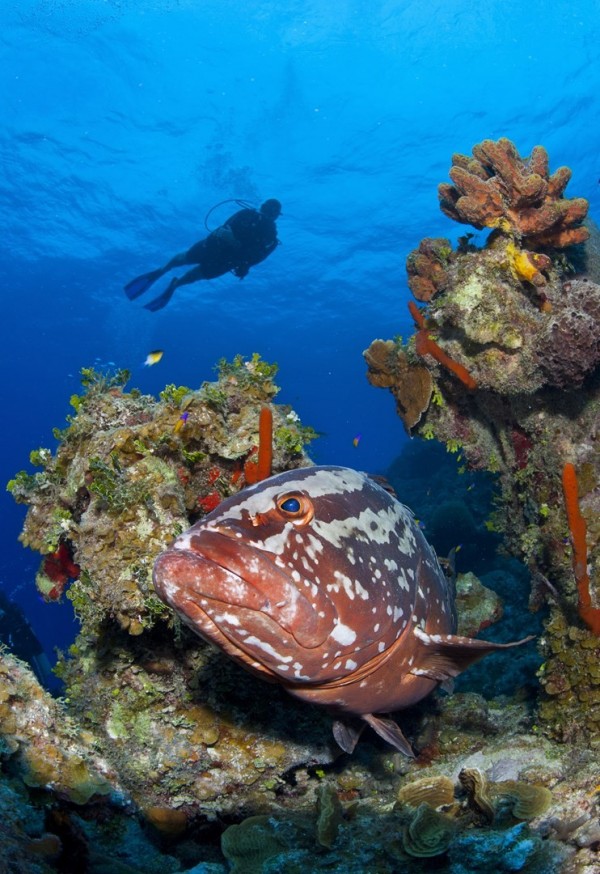 For a better experience on Ocean Frontiers, Update Your Browser.
For a better experience on Ocean Frontiers, Update Your Browser. Grouper Moon Project Strives to Save the Endangered Nassau Grouper
- Stephen Broadbelt
- January 19th 2014

- During the coming winter full moon, in late January and early February, the normally solitary and territorial Nassau grouper will travel a long way to gather at spawning sites. Watching the activity carefully (as they have been doing for more than a decade) will be marine scientists and researchers of the Grouper Moon Project, a collaboration of the Cayman Islands Department of Environment (DOE) and the Reef Environmental Education Foundation (REEF).
- The Grouper Moon Project had its beginnings in 2002 after an estimated 2000 fish were taken from the unprotected Little Cayman site. To reduce fishing pressure and allow the Department of Environment to monitor the site, Cayman’s Marine Conservation Board implemented an alternate-year fishing strategy. In 2003 based on Nassau grouper population numbers, the decision was made to impose an 8-year ban on fishing the aggregations. The ban was extended in late 2011 and is set to expire in 2019. With a mission to understand the fish aggregation and take the necessary steps to protect the species, team members collect information and build a case on behalf of the Nassau grouper.
- “Our aim is to support best management practices for Nassau grouper,” says REEF Director of Science Christy Pattengill-Semmens. “The whole idea behind the Grouper Moon Project is to better understand the Nassau grouper aggregation and then provide the best information the Cayman Islands government so they can better manage the species.”
- Through the years the project has grown in scope and support, including research at historical aggregation sites in Cayman Brac and Grand Cayman. Current components include: acoustic fish tagging, genetic studies, satellite tracking of drifting baby grouper, juvenile habitat research and educational outreach.
- “The data collected through the Grouper Moon Project has enabled the Department of the Environment to build a convincing argument for protection,” says Tim Austin, Deputy Director of Research and Assessment for the Cayman Islands Department of Environment. “We measure success by the increase in the number of groupers that show up at the site each year and by the increasing abundance on our routine fish monitoring research dives around the island for the rest of the year.”
- So far the protective measures introduced a decade ago are having a meaningful and positive impact − good news for the endangered Nassau grouper and all who care about it. This includes marine wildlife artist and conservationist Guy Harvey, who has helped spread the positive message through a documentary.
- “The importance of the documentary Mystery of the Grouper Moon is in letting the rest of the world know that the Cayman Islands is taking a responsible role in conserving an iconic reef species,” he says. “It is important to let people know that the conservation efforts are working and long term management of these valuable species is important to environmental sustainability and to the socio economic wellbeing of Caribbean countries.”
- Educating the next generation of Caymanians about the conservation work being done is important to the people behind the Grouper Moon Project. In advance of the aggregation, December workshops were held on Grand Cayman and Cayman Brac to distribute a marine science curriculum with lesson plans and free materials for teachers who want to introduce the Nassau grouper issue in their classrooms. Students learn about the grouper’s historical role in Cayman, the serious decline in its population and the conservation challenges the species now faces.
- “As they explore the aggregation with me, the immediacy and reality of the experience really touches them,” says scientist and host Brice Semmens. “Put simply, we are giving students their first diving experience -- and it happens to be with thousands of huge, endangered reef fish.”
- Christy Semmens says they want local schoolchildren to feel proud of the work being done in the Cayman Islands. “The Nassau grouper is such an icon for the Caribbean and it’s really a source of pride to have one of the healthiest grouper populations in the Caribbean, ” she says.
- “The research has revealed other characteristics of Nassau grouper that further lend evidence to why aggregation fishing is so detrimental,” says Tim Austin. “Older, larger and more experienced fish are important in locating the spawning sites and leading new recruits to the area. Older fish tend to spend more time at an aggregation and are therefore more susceptible to being caught.”
- Austin says science has also helped them conclude that fish eggs spawned in Cayman return as juvenile fish to Cayman because of offshore oceanographic conditions. Observations also help the department better understand how, when and why fish show up at certain locations, which helps protect the right areas at the right time of year.
- “We have learnt that grouper aggregations can move and so the original sites that we protected needed to be expanded to take into account the more subtle shifts in the peak density of the aggregation,” he says.
- Project leaders say that ultimately protection of the Nassau grouper relies on everyone who cares about the species doing their part to save it, and then carrying the message and passion to inspire changes that are needed.
- “The Grouper Moon Project is such a rewarding project to be involved in – to work with such a committed team and do great and interesting science,” says Christy Pattengill-Semmens. “We know education works and we are reaching out hoping to make a difference for this amazing species.”
Comment form
User Comment(s)
Total Comment(s): 0
No Comment(s) Founds

